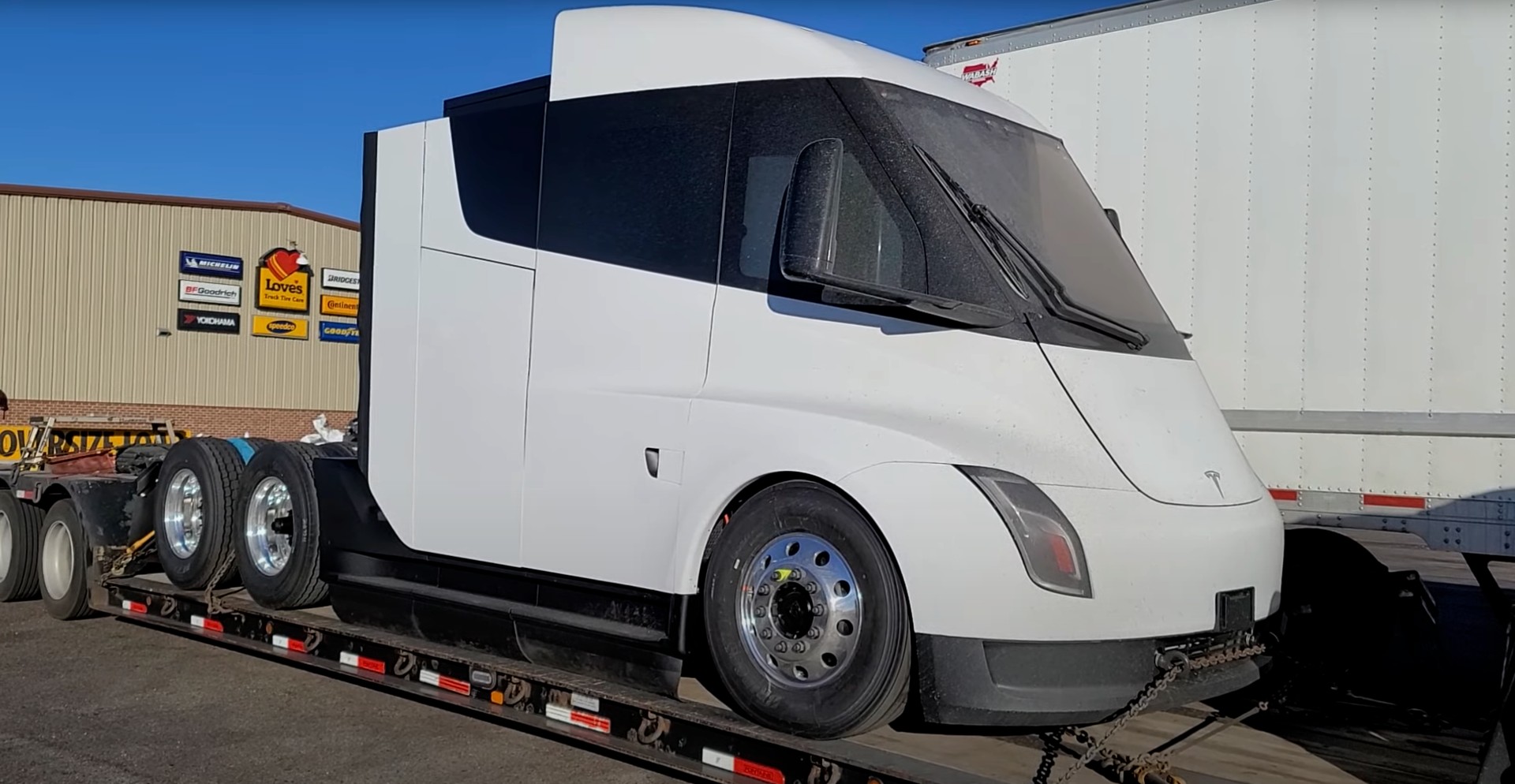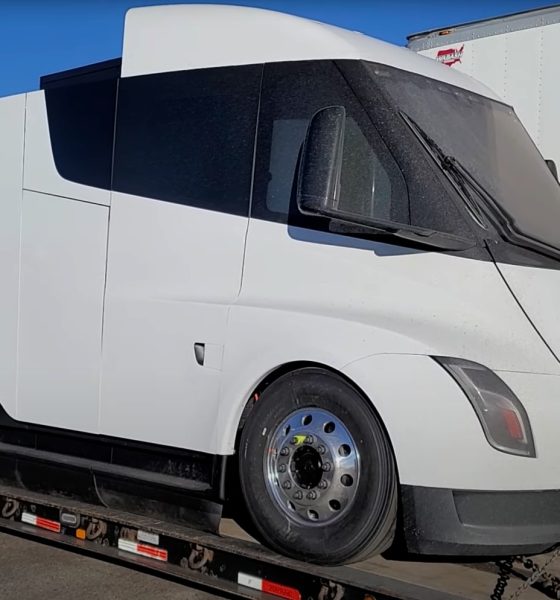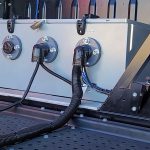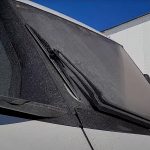

News
Tesla Semi production rumors swirl as frequent sightings up the ante on expectations
Rumors surrounding the Tesla Semi are plentiful in this day and age, especially as sightings of the company’s commercial vehicle are becoming more frequent. Expectations for the new Semi are high already, and Tesla aims to deliver the truck in a timely fashion after several delays.
The new Semi has been spotted numerous times over the past week, hinting toward ongoing testing before Tesla starts volume production of the massive, all-electric commercial vehicle. Less than two weeks after Tesla’s Q4 2020 Earnings Call, where CEO Elon Musk and others detailed the ongoing offensive to develop the vehicle, the Semi is being spotted by people on public roads. Although Musk stated battery constraint is the hold-up in the Semi’s production, it isn’t stopping the company from testing several new truck builds.
Speculation regarding when Tesla will finally begin volume production is growing, and more rumors surrounding the initial deliveries to pre-orderers appear on what seems like a daily basis. However, the big bottleneck is batteries, and Tesla plans to combat this issue with wide-scale cell production and purchasing. The real question is, how many cells will be “enough?”
EXCLUSIVE: For a few weeks I’ve been in contact with a source from a U.S Tesla supplier. They supply certain parts for the S,X,3 and Y, but I’m here to reveal some info on Tesla Semi. As always, take these kinds of things with a grain of salt. Things/timelines can change.
1/6
— Sawyer Merritt ?? (@SawyerMerritt) February 4, 2021
Elon Musk’s Earnings Call Comments
Musk, who stated last year that it was time for Tesla to enter volume production of the Semi, had a different tune during the Q4 2020 Earnings Call on January 27th. Battery cell constraint is a major bottleneck in starting the Semi production, as fulfilling the number of orders it has would likely inhibit Tesla from being able to produce its mass-market passenger vehicles, like the Model 3 and Model Y.
Tesla has recently started producing its own battery cells at a plant that sits adjacent to its main production facility in Fremont, California. Known as the “Kato Road Facility,” Tesla is building its new 4680 cells there, a battery that Tesla claims will cut the cost of its vehicles massively, putting it on a crash course to reach price parity with gas-powered vehicles. The Semi will require significantly more cells than any other Tesla vehicle to date, a problem that the company is aiming to solve by producing its own cells and buying additional ones from third-party suppliers like Panasonic.
Tesla’s 4680 Kato Rd. facility has a top 10 capacity, and it’s not even close to finished
During the Earnings Call, Musk said:
“Prototypes are easy. Scaling production is very hard. So a big part of the reason — the main reason we have not accelerated new products is — like, for example, Tesla Semi is that we simply don’t happen our cells group. We — this — if we were to make the Semi like right now, which we could easily go into production with the Semi, but we would not have enough to cells built for it right now. We will have cells group in ourselves for Semi when we are producing the 4680 volume. But for example, Semi would use typically five times the number of cells that a car would use, but it would not sell for five times what a car would sell for. So it kind of doesn’t make — it would not make sense for us to do the Semi right now, but it will absolutely make sense for us to do it as soon as we can address the cell production constraint. The same would go for that.”
Effectively, Musk explained that it makes more fiscal sense to focus on the mass-market consumer products for right now. When the Kato Rd. Facility begins a massive production of the 4680 cells, Tesla can begin the Semi production efforts, but that doesn’t mean prototypes aren’t on the road now.
New Sightings
Following a sighting by The Kilowatts last week, two new sightings of the Semi have surfaced of the all-white Tesla commercial vehicle.
New Tesla Semi with updated windows, door handles, and tail lights spotted in Sacramento
One video from Cory Draper on YouTube shows a four-and-a-half-minute-long walk around of the Semi, getting a close-up look at the vehicle. One of the most striking features is the size of the power cell, as Draper estimates it is between four and five feet in length. A massive truck requires a massive power source, and the Semi’s sizeable battery storage compartment will drive the truck’s 300 or 500-mile range. Another video from Ivaylo Tzintzarsky shows the power cell from the opposite side.
- YouTube: Cory Draper
- YouTube: Ivaylo Tzintzarsky
There are also numerous sensors that can be seen on the Semi, especially in Draper’s video. The top of the windshield is outfitted with at least five sensors that will help with the autonomous driving functionality of the Tesla Semi. Autonomy could help with the evolution of the trucking industry, as many drivers are currently restricted to 11 hours of travel per day, according to the Federal Motor Carrier Safety Administration (FMCSA).
Fuel savings alone could pay for a Tesla Semi, as the company estimates it will save at least $200,000. Combined with superior aerodynamic performance and, a quad-motor powertrain, and a low center of gravity to prevent rollovers, the Tesla Semi has the potential to revolutionize the trucking industry forever. The question is: When will it begin production, and how long until Tesla can produce the 4680 cells in mass quantities to solve the constraint issue?
Watch the two newest sightings of the Semi below. Let us know what you think in the comments!

News
Tesla FSD fleet is nearing 7 billion total miles, including 2.5 billion city miles
As can be seen on Tesla’s official FSD webpage, vehicles equipped with the system have now navigated over 6.99 billion miles.

Tesla’s Full Self-Driving (Supervised) fleet is closing in on almost 7 billion total miles driven, as per data posted by the company on its official FSD webpage.
These figures hint at the massive scale of data fueling Tesla’s rapid FSD improvements, which have been quite notable as of late.
FSD mileage milestones
As can be seen on Tesla’s official FSD webpage, vehicles equipped with the system have now navigated over 6.99 billion miles. Tesla owner and avid FSD tester Whole Mars Catalog also shared a screenshot indicating that from the nearly 7 billion miles traveled by the FSD fleet, more than 2.5 billion miles were driven inside cities.
City miles are particularly valuable for complex urban scenarios like unprotected turns, pedestrian interactions, and traffic lights. This is also the difference-maker for FSD, as only complex solutions, such as Waymo’s self-driving taxis, operate similarly on inner-city streets. And even then, incidents such as the San Francisco blackouts have proven challenging for sensor-rich vehicles like Waymos.
Tesla’s data edge
Tesla has a number of advantages in the autonomous vehicle sector, one of which is the size of its fleet and the number of vehicles training FSD on real-world roads. Tesla’s nearly 7 billion FSD miles then allow the company to roll out updates that make its vehicles behave like they are being driven by experienced drivers, even if they are operating on their own.
So notable are Tesla’s improvements to FSD that NVIDIA Director of Robotics Jim Fan, after experiencing FSD v14, noted that the system is the first AI that passes what he described as a “Physical Turing Test.”
“Despite knowing exactly how robot learning works, I still find it magical watching the steering wheel turn by itself. First it feels surreal, next it becomes routine. Then, like the smartphone, taking it away actively hurts. This is how humanity gets rewired and glued to god-like technologies,” Fan wrote in a post on X.
News
Tesla starts showing how FSD will change lives in Europe
Local officials tested the system on narrow country roads and were impressed by FSD’s smooth, human-like driving, with some calling the service a game-changer for everyday life in areas that are far from urban centers.

Tesla has launched Europe’s first public shuttle service using Full Self-Driving (Supervised) in the rural Eifelkreis Bitburg-Prüm region of Germany, demonstrating how the technology can restore independence and mobility for people who struggle with limited transport options.
Local officials tested the system on narrow country roads and were impressed by FSD’s smooth, human-like driving, with some calling the service a game-changer for everyday life in areas that are far from urban centers.
Officials see real impact on rural residents
Arzfeld Mayor Johannes Kuhl and District Administrator Andreas Kruppert personally tested the Tesla shuttle service. This allowed them to see just how well FSD navigated winding lanes and rural roads confidently. Kruppert said, “Autonomous driving sounds like science fiction to many, but we simply see here that it works totally well in rural regions too.” Kuhl, for his part, also noted that FSD “feels like a very experienced driver.”
The pilot complements the area’s “Citizen Bus” program, which provides on-demand rides for elderly residents who can no longer drive themselves. Tesla Europe shared a video of a demonstration of the service, highlighting how FSD gives people their freedom back, even in places where public transport is not as prevalent.
What the Ministry for Economic Affairs and Transport says
Rhineland-Palatinate’s Minister Daniela Schmitt supported the project, praising the collaboration that made this “first of its kind in Europe” possible. As per the ministry, the rural rollout for the service shows FSD’s potential beyond major cities, and it delivers tangible benefits like grocery runs, doctor visits, and social connections for isolated residents.
“Reliable and flexible mobility is especially vital in rural areas. With the launch of a shuttle service using self-driving vehicles (FSD supervised) by Tesla in the Eifelkreis Bitburg-Prüm, an innovative pilot project is now getting underway that complements local community bus services. It is the first project of its kind in Europe.
“The result is a real gain for rural mobility: greater accessibility, more flexibility and tangible benefits for everyday life. A strong signal for innovation, cooperation and future-oriented mobility beyond urban centers,” the ministry wrote in a LinkedIn post.
News
Tesla China quietly posts Robotaxi-related job listing
Tesla China is currently seeking a Low Voltage Electrical Engineer to work on circuit board design for the company’s autonomous vehicles.

Tesla has posted a new job listing in Shanghai explicitly tied to its Robotaxi program, fueling speculation that the company is preparing to launch its dedicated autonomous ride-hailing service in China.
As noted in the listing, Tesla China is currently seeking a Low Voltage Electrical Engineer to work on circuit board design for the company’s autonomous vehicles.
Robotaxi-specific role
The listing, which was shared on social media platform X by industry watcher @tslaming, suggested that Tesla China is looking to fill the role urgently. The job listing itself specifically mentions that the person hired for the role will be working on the Low Voltage Hardware team, which would design the circuit boards that would serve as the nervous system of the Robotaxi.
Key tasks for the role, as indicated in the job listing, include collaboration with PCB layout, firmware, mechanical, program management, and validation teams, among other responsibilities. The role is based in Shanghai.
China Robotaxi launch
China represents a massive potential market for robotaxis, with its dense urban centers and supportive policies in select cities. Tesla has limited permission to roll out FSD in the country, though despite this, its vehicles have been hailed as among the best in the market when it comes to autonomous features. So far, at least, it appears that China supports Tesla’s FSD and Robotaxi rollout.
This was hinted at in November, when Tesla brought the Cybercab to the 8th China International Import Expo (CIIE) in Shanghai, marking the first time that the autonomous two-seater was brought to the Asia-Pacific region. The vehicle, despite not having a release date in China, received a significant amount of interest among the event’s attendees.










